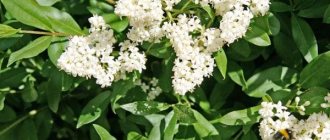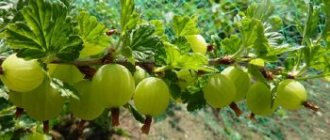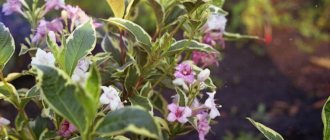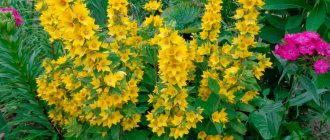Types and varieties of plants, appearance
Gooseberry is a large, voluminous shrub that reaches a height of just over 1 m. The branches of this plant have a large number of thorns, young shoots resemble a cylinder in shape, and they also have a lot of thorns. Gooseberry leaves are not too large, round in shape. The flowers of the plant have a green, amber or reddish tint. Rose hips are oval in shape and the veins are clearly visible on them. The berries usually ripen in June-August.
Let's figure out what the best varieties of gooseberries exist, among them:
- English yellow;
- Emerald;
- Russian;
- Change;
- Honey;
- Pink early;
- Moscow;
- Red;
- Spring;
- Souvenir;
- Dessert;
- Chernomor;
- Gooseberry Mucurines;
- Spring;
- Jubilee;
- Kolobok;
- Spinefree;
- Consul.
The most famous varieties
There are more than 3,000 thousand varieties of gooseberries in the world. The most popular in our latitudes are frost-resistant varieties that can safely survive harsh winters. In addition, when choosing seedlings, gardeners pay attention to the height of the shoots, crown diameter, ripening time, fruit size, color and taste.
The best varieties for regions with harsh climates
Winter-hardy varieties were bred specifically for those regions where harsh, long winters prevail. They begin to bloom in early spring at an average daily temperature of +5°C and easily tolerate spring frosts.
Did you know? Varieties with dark-colored berries contain much more vitamins, microelements and other useful substances, but they require more care when growing.
- Aristocrat characterized by large berries of at least 6 g, bright red color, aristocratic sweet and sour taste. The basal shoots are thick, straight, and low-thorned.
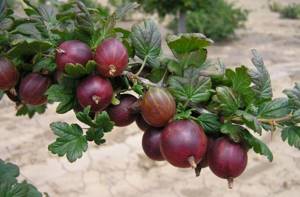
- White Nights - a dessert variety with small white sweet berries. The bush is small, prickly, dense and compact.
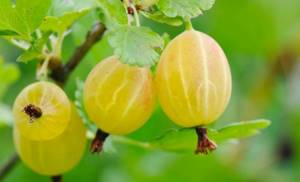
- Harlequin has medium berries weighing up to 5 g of dark cherry color. The taste is interesting, sweet with a memorable sourness. The trunks are low-thorned, arched, up to 1 m high.
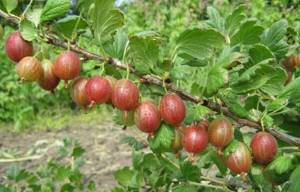
- Strawberry. The name of the variety speaks for itself: gooseberries, weighing about 5 g, have a delicious taste with strawberry notes. The color of the berries is light green, but under the sun's rays the berries take on a burgundy hue. The bush is medium-sized, compact, prickly.
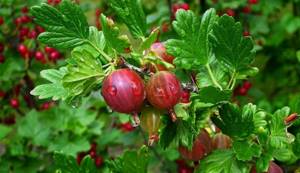
- Commander characterized by small sweet and sour berries, almost black in color. The bush is very beautiful, dense, but compact with a lot of thorns on the shoots.
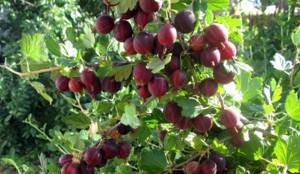
- Grushenka the appearance of the berries resembles a pear: the fruits are round, narrowed towards the stalk, medium in size, purple in color with a sweet and sour taste. The slightly spreading compact bush is characterized by high resistance to spring frosts and various viral diseases. The shoots are distinguished by the absence of thorns.
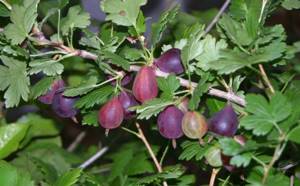
The most popular large-fruited varieties
Large-fruited varieties are especially popular among gooseberry lovers. Large berries are a wonderful decoration not only for the table, but also for the garden.
- Kolobok got its name from the shape of the berries: they are large (about 7 g) and resemble a ball. The taste is sweet and sour. The fruits hang down from the branches one by one. The variety is self-fertile and can pollinate without the help of bees.

- Cooperator characterized by round pear-shaped berries of a dark red color with a sweet dessert taste. The shoots are bent and thornless. The bush is slightly spreading, up to 1 m high.
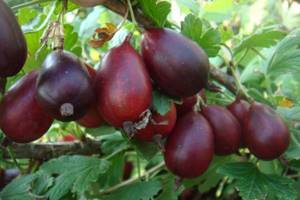
- Beryl has spherical fruits of bright salad color. Dessert variety, very sweet. The height of the bush does not exceed 1 m in height, the diameter of the compact crown corresponds to the height of the shoots. The thorns are concentrated only on the lower part of the shoots, which does not complicate harvesting. Easily tolerates frosts down to -36°C and is not susceptible to fruit rot.
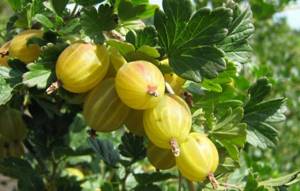
- Defender characterized by fruits of burgundy, tending to black, pear-shaped color. The berries have a sweet taste with subtle sour notes. The bushes are tall. Powerful pagons reach a height of 2 m.

- Amber - an extremely early variety with large amber-colored berries. The taste is delicate, sweet with a slight sourness. The bush reaches 1.5 m in height and bears fruit abundantly. Thorns are rare.
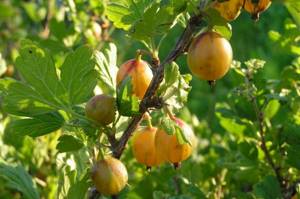
Benefit
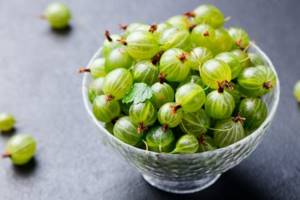
Gooseberries are quite rich in vitamins, macro and microelements, including:
- phosphorus;
- magnesium;
- potassium;
- iron;
- sodium;
- vitamin A;
- vitamin PP;
- vitamin B;
- vitamin C.
In addition, gooseberries have a laxative and diuretic effect, which helps cleanse the body and lose excess weight. Gooseberries help speed up metabolism and also give you energy. Gooseberries are very useful to eat with honey if a person suffers from obesity, hypertension, or has complaints of anemia. Women should also include gooseberries in their diet during menstruation or during uterine bleeding.
Organic acids and vitamins in gooseberries
Gooseberries are one of the most common berry crops. Its berries contain a large amount of sugars (5-15%) and useful organic acids, are rich in various mineral salts, and serve as a source of many vitamins (A, C and especially P). Gooseberry fruits contain tannins and coloring substances that are part of vitamin P. The juice of fresh berries contains a lot of pectin substances, which help remove radioactive substances from the human body.
The fruits of the common gooseberry contain sugars (13.5-19%), organic acids (2%), minerals, including a lot of copper, potassium (260 mg •%); phosphorus (28 mg • %), iron (0.8-1.6 mg • %), vitamins C (up to 35 mg • %), B1 B2, PP (0.25 mg • %), K (30 mg • %), pectins.
Rejected gooseberry leaves contain organic acids, cyanogenic compounds, catechins, flavonoids (astragalin). The fruits are tasty and nutritious, they contain carbohydrates (1.05%), pectins (1.13%), organic acids (up to 2%), vitamin C (up to 54 mg • %), catechins, leukoanthocyanidins, flavonoids, etc. including quercetin, kaempferol. The seeds contain up to 20% fatty oil.
Application
In cooking

Gooseberries are quite popular in cooking; they are consumed both fresh and made into preserves, jams, and compotes. Homemade marmalade is also often made from gooseberries. These berries can be closed for the winter, for example, gooseberries with spices or currants and zucchini.
In medicine
Gooseberries can be consumed using traditional medicine. For diseases of the gastrointestinal tract, you can treat with a decoction of berries, mixing 1 tbsp. l. chopped berries with 1 cup of boiling water, then boil the mixture for 10 minutes. You need to take this decoction ½ cup 4 times a day, you can add sugar if desired. Also, berries or decoctions are recommended for use by older people who are obese or have diabetes. An infusion of rosehip leaves is also used for tuberculosis.
When losing weight
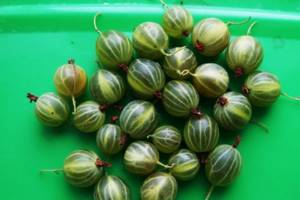
Since gooseberries contain a large amount of fiber, they can and should be consumed while losing weight. This berry will help you cleanse your body of toxins and waste. There is also a gooseberry diet, in which you need to consume 1.5 kg of berries throughout the day, divided into 3 doses. In addition to fruits, it is allowed to consume kefir, cottage cheese, and porridge.
At home
As mentioned above, gooseberries are a healthy berry that can be used in everyday life for making desserts, for preservation, and also in traditional medicine.
In cosmetology
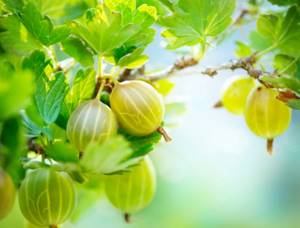
Gooseberries can be used in cosmetology by making a mask out of it. For dry and delicate skin, ¼ cup should be mixed with the same amount of milk, then soak a gauze cloth in this mixture and place it on the face for 15 minutes, covered with a damp towel. At the end, the skin should be blotted and lubricated with moisturizer. For oily skin, you can grind gooseberries through a sieve, add rice flour to them, and then apply to a steamed, clean face. Keep this mask on for 20 minutes, then rinse with water and pat dry with a towel.
Wild related species
In the wild, gooseberries are found on all continents of the Earth, mainly in mountainous areas, along river banks and in forests. With similar botanical characteristics, the bushes differ greatly in their resistance to frost and various diseases, depending on their climatic zones.
Did you know? The now popular yoshta berry appeared as a result of crossing black currants with gooseberries.
In our area, wild relatives of gooseberries can be found in the Caucasus, Altai, Siberia, in the European part of Russia and in the Western regions of Ukraine, as well as in the forests of Belarus. Altai and Siberian gooseberries are characterized by maximum cold resistance and unpretentiousness.
All wild plants of the Gooseberry family in our latitudes are divided into three types:
- European;
- needle;
- Far Eastern.
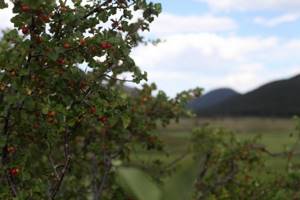
Gooseberries are also common in North Africa and North America. These varieties are less resistant to climatic anomalies, but at the same time, they are less susceptible to various diseases, bacteria and fungi. The main feature of the American gooseberry is its resistance to powdery mildew.
How to grow, care, pests and diseases
Gooseberries, like many other berries, love the sun, so if you plant a bush somewhere in the shade, don’t expect a lot of fruit. Gooseberries also do not like wet soil, so areas with high groundwater are best avoided. Bushes are planted in a permanent place in the spring or autumn, however, experienced gardeners like to plant in the autumn.
When planting, you should remember the distance between the bushes - for small varieties 1 m is enough, larger ones should be planted 2 m from each other. To ensure that the bush receives enough nutrients, the pit is fertilized with manure, fallen leaves, potassium sulphide, and wood ash.
Before planting gooseberries, remove the tops and dried roots, leaving 5 buds on each branch. In the hole, the bush should be located slightly at an angle, and the ground should be loosened periodically. Do not forget to periodically feed the bush and cut off old dried branches. Gooseberries are often attacked by sawflies and aphids, so to combat them, the bush should be treated with karbofos or ash infusion.
Gooseberry care
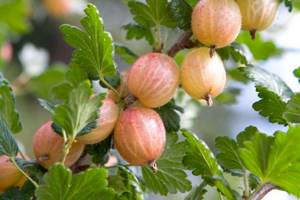
Planting and growing gooseberries is quite simple, especially if the gardener adheres to all the rules of agricultural technology for this crop. In early spring, when the snow has not yet melted, the bushes need to be sprayed with boiling water using a spray bottle. This treatment is carried out for the purpose of prevention against various diseases and pests.
It is necessary to loosen the soil surface around the plants to a depth of 8 to 10 cm in May. To reduce the amount of loosening in the future, the area should be covered with a layer of mulch. If there is such a need, then at the same time the bush should be fed with a solution of nitrogen and potassium fertilizers or manure infusion.
Gooseberries react extremely negatively to insufficient moisture in the soil, especially during flowering (spring) and during the ripening period of berries (summer). Experts recommend using drip or subsoil irrigation, in which case the water will immediately reach the root system of the shrub (to a depth of 5–40 cm). During the entire growing season, the shrub will need to be watered 3–5 times in this way. Irrigation by sprinkling is not suitable for gooseberries, especially using cold water. If in the spring the soil around the bushes was covered with mulch, the amount of weeding and loosening will sharply decrease. However, if there is still a need to remove weeds or loosen the soil, then such procedures must be carried out, despite the sharp spines of the plant.
For bushes planted in rows, the hanging branches must be raised with guy ropes or nets, which should be stretched between the rows at a height of 0.25–0.3 m on both sides of the row.
Gooseberry. Caring for gooseberries in summer. (07/10/16)
Gooseberry care in autumn
In autumn, gooseberries will need to be prepared for wintering. In order for the bush to lay fruit buds for next year, it must not need nutrients, so it needs to be fed. Also, pruning is done in the autumn, because it is not recommended to do it in the spring.
Fertilizer
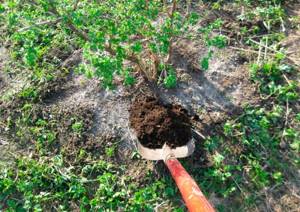
Such a shrub produces rich harvests for many years, and at the same time it needs nutrients that it takes from the soil. In this regard, it is recommended to feed gooseberries every year, using both organic and mineral fertilizers. In spring, under 1 bush you need to add 50 grams of superphosphate, 25 grams of potassium sulfate, ½ bucket of compost and 25 grams of ammonium sulfate. If the bush is very large and produces high yields, the specified amount of fertilizer should be doubled. Fertilizers are applied to the soil along the perimeter of the crown, since it is in this diameter that the root system of the bush is located. To incorporate fertilizers into the soil, it must be loosened. As soon as the plant fades, it needs to be fed with a solution of mullein (1:5), with 5 to 10 liters of nutrient solution taken per bush. Repeated feeding with mullein is carried out after 15–20 days.
Preparation and storage

- Fresh gooseberries can be stored in the refrigerator for up to 10 days.
- If you seal compotes, preserves and jams, then the shelf life increases to several years, however, you must follow all preservation rules.
- It is better not to store grated gooseberries with sugar for a long time or to freeze them.
- Frozen whole gooseberries can be stored in the freezer for up to 1-2 years.
Community of little green men
Grossularia, Gooseberry. Shrub with alternate 3-5-lobed, glabrous or pubescent leaves. The shoots have thorns at the nodes and spines at the internodes; flowers are often bisexual, sessile, usually collected 1-3 in a raceme; fruits are false berries, round or oblong, glabrous or pubescent, white, yellow, green, red, purple or black in color.
Types and varieties of gooseberries
There are over 50 known wild gooseberry species, distributed in North America (about 50 species), Europe and Asia (4 species). There are 3 wild species known in Russia: needle gooseberry (Grossularia acicularis), growing in the mountainous regions of Siberia and Central Asia, and rejected gooseberry (Grossularia heclinata), found in the North Caucasus.
Also interesting for landscaping is the Bureya gooseberry (Grossularia burejensis), which is considered winter-hardy, from the Far East (rare in cultivation).
European gooseberry, or rejected gooseberry, common gooseberry (Grossularia reclinata)
Homeland - territory from the Carpathians to the Caucasus.
Thorns are located on annual shoots and in the internodes of old branches. Leaves with 3-5 rounded, blunt-toothed lobes, dull, short-fluffy on both sides; the flowers are greenish or reddish, in bunches of 1-2 pieces. The fruits are up to 1.5 cm in diameter, greenish, yellow or purple.
The species is characterized by an early onset of vegetation and foliation. It blooms in May-June, the fruits ripen in July - early August.
The species served as the ancestor of most varieties of gooseberries, early-fruiting, productive, durable, with a high content of sugars, acids and vitamins in the berries.
Needle gooseberry, or Altai gooseberry (Grossularia acicularis)
Homeland - Siberia, Kazakhstan.
Annual and old shoots are densely covered with needle-shaped spines, the spines at the nodes are 3-partite; the leaves are shiny on top. The flowers are solitary. The berries are bare, up to 1.5 cm in diameter, edible.
The species is winter-hardy.
Gooseberry varieties
The ancestral home of the gooseberry is the Himalayas, but currently it has taken root in almost all climatic zones. The culture of this plant is well developed in Great Britain, the Netherlands, Belgium and France (mainly varieties of rejected gooseberries are cultivated there); in other countries, gooseberries are of less importance. In our country, it has been known as a berry crop since the 11th century. Gooseberries in Rus' began to be grown much earlier than currants. In the former USSR, over 100 of its varieties were zoned.
Gooseberries are one of the most valuable early ripening berry crops. Its very juicy, sweet, slightly pleasantly acidic fruits contain 8-11% sugars (among European fruits, gooseberries are second only to grapes in this indicator, which is why they are sometimes called “northern grapes”), 1.2 -1.7% organic acids, 0.88% pectin, vitamins C (30-60 mg per 100 g of juice), B, P, provitamin A (carotene), iron salts, phosphorus.
Currently, more than 4,000 varieties of gooseberries are known, which are divided into 3 groups: European, American and hybrid .
Most European varieties are descended from the rejected gooseberry. They are distinguished by larger berries, high taste, poor frost and drought resistance, suffer greatly from powdery mildew, and are propagated by layering and green cuttings.
American varieties are obtained mainly from crossing American species: gooseberry (Grossularia hirtella), rose gooseberry (Grossularia sunosbari), Missouri gooseberry (Grossularia missourensis) and variety var. uva crispa is a variety of the European gooseberry variety. These varieties are characterized by strong growth, relatively small fruit, resistance to powdery mildew, and higher frost resistance.
The third group, which forms the basis of the modern assortment in Russia, was obtained as a result of crossing North American varieties with European ones . Varieties of this group have good winter hardiness, early fruiting (in the 2-3rd year after planting), weak thorniness or thornlessness of shoots, and good rooting ability during propagation.
Popular gooseberry varieties
'African' is a winter-hardy, drought-resistant, high-yielding variety. The bushes are medium-sized, medium-spreading. The berries are small (1.5-3.5 g), black with a waxy coating, sweet and sour. The variety is resistant to pests and diseases, is not susceptible to powdery mildew, but is affected by anthracnose. The thorniness is weak; if you immediately cut out shoots with single thorns as they appear, you can grow a completely thornless bush;
'Ballet', 'Prima' - winter-hardy variety, medium ripening period. May be damaged by powdery mildew. The bush is medium-sized, with thorns only in the lower part of the shoots. The berries are large and medium (5 g), round in shape, red, sweet and sour, aromatic;
'White Nights' is an early ripening winter-hardy variety. Resistant to powdery mildew and anthractose. The bush is medium-sized, compact. The spikes are average. The berries are medium-sized, yellowish in color, slightly pubescent, sweet;
'Grace' is a winter-hardy variety with medium ripening period. Resistant to powdery mildew. The bush is medium-sized. The berries are large, green;
'Vladil', 'Commander' - a variety of medium-early ripening. Winter hardiness and yield are average. The bushes are medium-sized, medium-spreading. The berries are medium-sized (up to 4.2 g), dark red, sweet and sour. The bushes are almost thornless. Resistance to powdery mildew is high;
'Grushenka' is a winter-hardy variety with medium ripening period. Flowers are rarely damaged by spring frosts. Resistant to powdery mildew, septoria, and viral diseases. The bush is medium-sized. The berries are medium size, rounded pear-shaped, pleasant taste;
'Kazachok' is a winter-hardy variety with medium ripening period. Drought-resistant, resistant to powdery mildew. The bush is medium-sized. The berries are medium-sized, oval and slightly conical, dark plum, slightly pubescent, with a dessert taste;
'Kolobok' is a medium-ripening variety. Resistant to powdery mildew. The bushes are medium-sized, spreading. Winter hardiness and productivity are high. The berries are large (4.5-8 g), dark red in color with a strong waxy coating, and have good taste. The spininess is weak;
'Moscow Red' is a medium-winter-hardy variety with a medium-early ripening period. The yield is high. The berries are round-oval, dark red with a purple tint, matte, without pubescence, juicy, aromatic;
'Tender' is a highly winter-hardy variety with a medium ripening period. Resistant to powdery mildew. The bush is medium-sized, compact. The spininess is weak. The berries are medium-sized (4-5 g), round-oval, red, with a waxy coating, tasty, aromatic;
'Eaglet' is an early ripening variety, medium-winter hardy, high-yielding. Resistant to powdery mildew. The bushes are medium-sized, medium-spreading, thornless. The berries are black, medium-sized and large, with a waxy coating, sweet and sour;
'Pink' is a medium-sized, erect bush. The berries are large - 5-7 g, delicate pink in color, with a slight waxy coating and thin skin. Ripen in the second ten days of July. The pulp is juicy, tender, of good taste;
'Russian' is a medium-winter-hardy, high-yielding variety of medium-early ripening. Resistant to powdery mildew. The bushes are vigorous, medium spreading. The berries are large (3-6 g), red, very tasty. The prickliness is medium;
'Russian Yellow' is a productive winter-hardy variety of medium ripening period. The bushes are medium-sized, medium-spreading. The berries are large (5-7 g), yellow, sweet and sour taste; hang on the bush for a long time without falling off. Quite resistant to powdery mildew. The prickliness is medium;
'Salyut' is a winter-hardy, high-yielding variety with medium ripening period. The bush is medium-sized, compact. The spikiness is average. The berries are large (3.2-6.6 g), round-oval, pink, when fully ripe - dark red, tasty, without aroma;
'Northern Captain' is a winter-hardy, high-yielding variety with a medium ripening period. The bush is tall, compact, with non-drooping branches. The berries are medium size (3-4 g), black in color, pleasant taste. Resistant to powdery mildew. The bushes are almost thornless;
'Secateurs' is a highly winter-hardy variety with a medium ripening period and tolerates spring frosts well. The bushes are medium-sized. The berries are medium size, dark red, sweet and sour taste. The spines are single and very rare. Resistant to powdery mildew;
'Date', 'Green Date', 'No. 8', 'Goliath' - a powerful bush with thick, arcuately hanging shoots, the tops of which are devoid of thorns. A variety of European origin with high yield (on average 3-9 kg per bush, and with good care - up to 20 kg and more) and large berries (usually at least 6.3 g, and with good nutrition - double or triple more). The fruits are hairless, oval, green at first, with a thick dark purple-red blush, and at the end of summer they are a deep cherry color. The variety is susceptible to spheroteca and powdery mildew. Moderately winter-hardy;
'Houghton', 'Houghton' is an American variety of medium ripening. Drought-resistant, frost-resistant, powdery mildew resistant. Medium sized bushes. The spikes are average. The berries are small (1-1.5 g), round in shape, dark red with a waxy coating, pubescent, sweet and sour;
'Hinnonmati strain 14', 'Hinnomati strain', 'Finnish' - variety bred in Finland. Early ripening, winter-hardy and resistant to powdery mildew. The bush is medium-sized. Medium prickly. The berries are medium-sized and small (2.8-3.5 g), round-oval, yellowish-green, without pubescence, with a waxy coating.
Gooseberry care
This is one of the most unpretentious and winter-hardy berry crops. However, gooseberries are less winter-hardy than black currants: frost damage to vegetative shoots and fruit formations occurs in severe winters with little snow, with high soil moisture in the fall. Fruit formations near the bushes freeze severely when thaws alternate with severe frosts. In the absence of snow cover, the gooseberry root system is very sensitive to low temperatures. Thus, in young bushes they freeze slightly at -3-4 °C and freeze out when directly frozen to -10 °C.
Gooseberries grow and produce crops in almost all types of soil (only waterlogged and acidic soils cannot be tolerated). This is due to the fact that its roots are located shallowly (their bulk is located at a depth of 50 - 60 cm). Gooseberries grow best in loamy, moderately moist, nutrient-dense soils with good breathability.
Gooseberries do not tolerate strong thickening and shading: in the shade the bushes develop worse, their resistance to pests and diseases weakens, the berries ripen at the same time, are poorly colored, and their quality deteriorates.
Sunny areas, protected from cold winds, are allocated for it, which are plowed to a depth of 35–40 cm a year before planting and organic (from 40 to 80 t/ha depending on the soil) and mineral fertilizers are added to the soil. The same fertilizers are applied to the soil annually. It is advisable to fertilize with organic or mineral fertilizers.
Planting is usually carried out in the fall with 2-3 year old seedlings, for which planting pits are prepared. Seedlings are planted without tilting, with a slight deepening of the root collar (by 5 - 6 cm), since renewal shoots are formed from dormant buds located on the buried parts of the plant. The most favorable planting time is autumn. Planting work begins at the end of September and ends in the 2nd ten days of October. Spring planting is undesirable, since gooseberries begin to grow very early and seedlings planted in spring do not take root well.
Plants begin to bear fruit 2-3 years after planting. Gooseberry fruit buds are formed in the second half of summer. Therefore, when harvesting, we must remember and take care of the next year’s harvest, that is, provide the bushes with food and moisture during this period.
In October, after leaf fall, you need to remove all fallen leaves, then remove dried fruits and loose leaves from the bushes, in which pupating pests can nest. If there are branches on the gooseberry bushes affected by powdery mildew, they should be cut out and burned, and the bushes should be treated with a solution of soda ash.
For gooseberries, autumn moisture-recharging watering (late September - early October) is very important to enhance root growth and improve overwintering conditions for plants. Depending on the humidity of the soil and air, one bush consumes from 40 to 60 liters of water.
Gooseberries are a self-fertile crop and set fruit when pollinated by pollen from their flowers. When pollen from flowers from other varieties is pollinated, berry set increases sharply. In different varieties of gooseberries, the berries differ in shape, size and color.
Gooseberries produce a lot of young shoots, leading to thickening of the bush, so pruning and shaping of the bush is necessary. Pruning begins from the 4th year by removing excess zero shoots. From the 6th-8th year, in early spring, old branches are cut out (they are distinguished by their dark color, strong downward curvature of the branches and their weak fruiting); an adult bush should consist of 20-25 branches of different ages. Young shoots are not shortened, since gooseberries bear fruit on last year's growths.
Gooseberry propagation
The main methods of propagating gooseberries are by arcuate, vertical and horizontal layering.
Reproduction by arcuate layering : a one- or two-year-old shoot towards the end is pressed to the ground with a peg. Then they tie it to a peg so that the top stands vertically. The place where the branch comes into contact with the soil is sprinkled with fertile soil and constantly kept moist. By autumn, roots have formed in this place and the young plant can be separated from the mother plant and transplanted to a permanent place. To speed up the root formation process, you can make a shallow cut on the branch.
Propagation
by vertical layering : the gooseberry bush is completely cut off in late autumn or early spring, leaving only stumps up to 3 cm high above the ground. Green shoots grow in large numbers on the remaining stumps.
If they are very thick and oppress each other, then they are thinned out, leaving the most strongly grown ones. When they reach a height of 15-20 cm, carefully hill up to half their height and water well. As the shoots grow, hilling is repeated, combined with mandatory watering and fertilizing. By autumn the shoots take root. It can be replanted to a permanent location in the fall or next spring. Before planting, the cuttings are carefully unplanted and separated with roots from the mother plant.
Reproduction by horizontal layering: in the spring, before the buds bloom from the bush, obliquely growing shoots are bent, having first dug a groove 6-7 cm deep along the length of the branch. The branch is carefully placed in the groove and secured to the bottom. When the green shoots reach a height of 12-15 cm, the groove is filled up to half the height of the shoots, trying not to damage them. As they grow, the soil is added 2-3 more times. By autumn, the shoots form roots. In autumn, the branch is separated from the mother bush and dug up. It is cut into individual seedlings and planted in pre-prepared holes.
Medicinal properties of gooseberries
Gooseberry has a diuretic, choleretic, mild laxative and analgesic effect. A decoction of its berries is prescribed for stomach cramps, to enhance the activity of the gastrointestinal tract. Fresh berries and various food products obtained from them are especially useful for children and the elderly with metabolic disorders and obesity.
Gooseberries are recommended for heart disease, hypertension, atherosclerosis, anemia, obesity, and for the prevention of radiation injuries. An infusion of leaves is used in the treatment of tuberculosis.
When eaten raw, only well-ripened fruits are tasty (ripeness is determined by the berries acquiring the characteristic color and softness of a given variety). Some varieties are very good for use as fresh desserts. Berries of dessert varieties should be sweet and sour, large, attractive in appearance, with delicate thin skin. Gooseberries contain many simple acids, thanks to which they go well with other berries in desserts. Due to the high content of pectin substances, gooseberries can be used to prepare good jellies, marmalade and marshmallows. Unripe, still firm berries are better suited for these purposes. Gooseberry fruits are also used for the production of fruit and berry wines.
Gooseberry root system: structure

Gooseberry root system: structure
Let's consider several characteristic features of the gooseberry root system.
The first characteristic feature of the gooseberry root system. If the gooseberry was propagated using the vegetative method, then if by cuttings or layering, then its root system will consist of small roots.
The second characteristic feature of the gooseberry root system.
These roots are called: adventitious, and they grow from root buds, usually not located in nodes.
The third characteristic feature of the gooseberry root system.
New roots appear on the adventitious ones, usually about nine to ten centimeters from the beginning of the first shoot.
The fourth characteristic feature of the gooseberry root system.
Subsequently, from the first adventitious roots, more and more new ones begin to grow, and so there are several orders of them.
The fifth characteristic feature of the gooseberry root system. The largest number of roots that provide the plant with the most nutrients are root hairs, which are usually found on roots of the fifth to eighth order.
The sixth characteristic feature of the gooseberry root system.
In an adult plant, all the roots are of different ages and are located directly under the bush.
The seventh characteristic feature of the gooseberry root system.
As a rule, such roots are far away and do not extend beyond the bush.
The eighth characteristic feature of the gooseberry root system.
If the soil is loose enough, the roots can go one and a half meters deep.
The ninth characteristic feature of the gooseberry root system.
Usually the common part, the main part of the roots, is located at a distance of fifteen centimeters to half a meter.
The tenth characteristic feature of the gooseberry root system. Since new adventitious roots constantly grow every year, and new orders of roots are formed, the age of all adventitious roots cannot be the same.
The eleventh characteristic feature of the gooseberry root system.
The plant is durable precisely because its roots are constantly renewed.
The twelfth characteristic feature of the gooseberry root system.
A high yield can be obtained if you properly care for the bush even at twenty-five years old.
The thirteenth characteristic feature of the gooseberry root system.
Proper care involves proper loosening and cutting off excess shoots.
A little history about gooseberries
Gooseberry is a plant about which there is not a single myth or legend. This may indicate that in those days people did not know about this berry or did not pay attention to it. Mentions of gooseberries on the territory of our country are found in the chronicles of Kievan Rus, dating back to the 11th century. In Europe, gooseberries began to be actively grown in the 15th and 16th centuries. In many countries, it was first planted as a hedge, after which its taste was discovered. Breeders in England worked to develop new varieties of gooseberries, increasing their yield and adjusting their appearance. It was the British who gave gardeners most of the existing varieties of berries.
After the discovery of America, this culture set out to conquer this continent. Due to the climate, gooseberries did not take root well and were susceptible to various diseases. Breeding came to the rescue; experts developed varieties that were drought-resistant, unpretentious to the soil, and suitable for the American climate.
Following Europe, the popularity of gooseberries came to the Russian Empire, they began to actively grow and eat them. At the end of the 19th century, breeders began working on its yield. Based on the experience of England, they created new varieties, achieving a weight of one fruit of 80 grams.
Researchers point out that previously gooseberries were larger and sweeter.
Gooseberry: plant description

Gooseberry: plant description
Gooseberry is a shrub from the Gooseberry family. This article will focus on an unpretentious and high-yielding variety. This variety impresses with its immune system, as well as low requirements for care and soil. It is also worth noting that this variety has a complete absence of thorns.
Gooseberry flower: structure
Let us consider the characteristic features of the structure of gooseberry inflorescences.
The first characteristic feature of the structure of gooseberry inflorescences. Gooseberry flowers are found on racemes on average on one raceme, maybe up to three flowers, they can also be single.
The second characteristic feature of the structure of gooseberry inflorescences.
They resemble bells in appearance and have five sepals and five petals.
The third characteristic feature of the structure of gooseberry inflorescences.
As a rule, the petals are either greenish, white, or with a red tint; there are five stamens inside the flower.
The fourth characteristic feature is the structural feature of gooseberry inflorescences.
The lower ovary has many, seven buds.
The fifth characteristic feature of the structure of gooseberry inflorescences.
The pestle that is on top is considered bipartite.
The sixth characteristic feature of the structure of gooseberry inflorescences. As mentioned above, gooseberries pollinate themselves.
The seventh characteristic feature of the structure of gooseberry inflorescences.
Well, insects love to visit gooseberries, the way its flowers secrete a certain nectar is necessary for cross-pollination of plants. The eighth characteristic feature of the structure of gooseberry inflorescences.
The harvest will increase significantly if bees fly near the gooseberries and the weather is mostly good during the season.
Disease Control
All major diseases that can threaten gooseberries are treated by spraying the bush with Bordeaux mixture. If the soil is affected, then water it with a solution of copper sulfate. The only disease that is difficult to get rid of is mosaic (shoot growth stops and a mosaic pattern appears on the leaves). Affected bushes are usually disposed of. To protect gooseberries from most pests, branches, leaves and berries are regularly treated with insecticides.
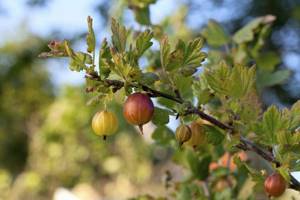
Diseases
The common gooseberry is a classic of the genre in the gardening community. It is found in almost every dacha, but not everyone knows how to properly care for and propagate it. The article above will help you complete your knowledge.
What are the benefits of gooseberries?
Russian yellow gooseberry - advantages and disadvantages
Gooseberries have very beneficial properties. They contain about 12% fructose and glucose, which is well absorbed by the body. The well-known gooseberry acid is due to the content of malic, oxalic and even citric acid, which have a positive effect on digestion. The high content of pectins makes the fruits of the plant an excellent natural remedy for removing radiation. In terms of the content of useful minerals, no other berry can compare with gooseberries.
The benefits of eating gooseberries are very great. Thanks to it, blood circulation and metabolic processes in the body are improved, the nervous system and hormonal processes are strengthened.

Juice
Since everything about gooseberries and their beneficial properties has been known for a long time, it is widely used in folk medicine. A decoction of the leaves and fruits of the plant helps with kidney disease, anemia, and hypovitaminosis. Berries are also useful for children, as they are an excellent general strengthening and anti-allergenic remedy.
Note! In the Caucasus, gooseberries were believed to help treat tuberculosis and pneumonia.
The berry has also found its use in modern medicine. It is used in the manufacture of various dietary supplements. It is recommended to use it to combat obesity and metabolic disorders. But, despite all the beneficial properties, gooseberries should not be consumed by people with diabetes.
Gooseberry: description, characteristic features of bushes
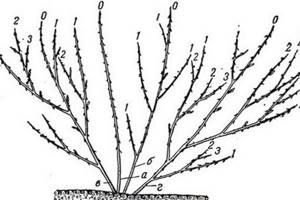
Gooseberry: description, characteristic features of bushes
First you need to figure out what a gooseberry is. Let's look at a few of them.
The first characteristic feature of a gooseberry bush.
This is a fairly small shrub, the usual height reaches about one and a half meters, and it is perennial.
The second characteristic feature of the gooseberry bush.
Shoots begin their formation from the root collar, which is located at the bottom of the bush; the shoots are also covered with thorns.
The third characteristic feature of a gooseberry bush.
The root collar of mature shrubs is quite large.
The fourth characteristic feature of a gooseberry bush.
Bushes that are about two decades old have a neck that can be ten to ten centimeters thick and about twenty-two to twenty-five centimeters long.
The fifth characteristic feature of a gooseberry bush.
During the period of plant growth, this part of it constantly increases, and more and more new shoots form around it.
The sixth characteristic feature of a gooseberry bush.
Ultimately, these young shoots turn into bush branches.
The seventh characteristic feature of a gooseberry bush.
If the bone grows freely enough, it can have about fifty-five or seventy shoots.
The eighth characteristic feature of a gooseberry bush.
They all differ in their characteristics, and no two are alike.
The ninth characteristic feature of a gooseberry bush.
The center of the bush consists of straight, fairly tall shoots.
The tenth characteristic feature of a gooseberry bush.
They practically do not branch, and they only have berries at the very top.
The eleventh characteristic feature of a gooseberry bush.
From which we can conclude that the central shoots are unproductive.
The twelfth characteristic feature of the gooseberry bush.
Due to the fact that the branches of the bush that are located outside receive more heat and better light, they produce a large number of fruits. Because of this, they can bend to the side.
The thirteenth characteristic feature of the gooseberry bush.
If the gooseberry does not have a large number of branches, on average it will bear fruit well for up to ten to twelve years; if the bush is dense enough, even new branches that have just appeared may begin to break off.

